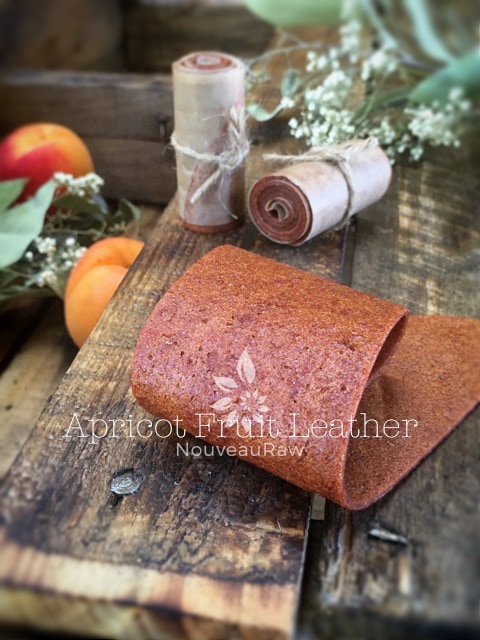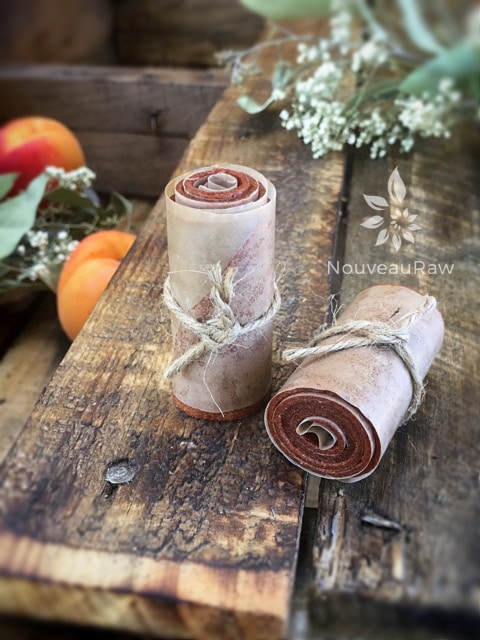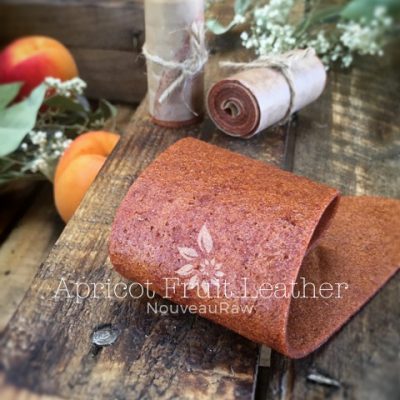Apricot Fruit Leather

 Add to favorites
Add to favorites

~ raw, vegan, gluten-free, nut-free ~
For the love of apricots…(spoken with an Italian accent as I throw my hands in the air)! I love this fruit leather!
An apricot in its raw state is somewhat acidic but the acidity decreases as it ripens and its sugar content increases. When it ripens, the vitamin A within also doubles and for the most antioxidants, choose fully ripened fruit. Some describe their flavor as almost musky, with a faint tartness that lies somewhere between a peach and a plum.
Start with the best Apricot
An Apricot should be well-formed and relatively firm. Pick apricots that are dark yellow or yellow-orange in color. Apricots are very fragile and should not be handled roughly or stored at high room temperatures.
To ripen apricots, place them in a sealed plastic or paper bag and keep them at room temperature. Avoid apricots that are dull looking, soft, mushy or extremely firm. Bruised areas will be obviously brown.
Ingredients:
yields 3 cups puree
- 9 ripe apricots, washed and stones removed
- 2 Tbsp chia seeds, ground to powder
- 1 Tbsp fresh lemon juice
 Preparation:
Preparation:
- Select RIPE or slightly overripe apricots that have reached a peak in color, texture, and flavor.
- Prepare the fruit; wash, dry, and remove the pits. Remove the skins (if desired) and any bruised areas.
- Puree the apricots, ground chia and lemon juice in your blender or food processor until smooth.
- Taste and sweeten if needed. Keep in mind that flavors will intensify as they dehydrate.
- When adding a sweetener do so a little at a time, and reblend, tasting until it is at the desired taste.
- It is best to use a liquid type sweetener such as raw honey or agave as an example.
- Don’t use a granulated sugar because it tends to change the texture of the finished fruit leather.
- Allow the mixture to rest for at least 10 minutes to allow the chia to thicken.
- Spread the fruit puree on teflex sheets that comes with your dehydrator.
- Pour the puree to create an even depth of 1/8 to 1/4 inch.
- If you don’t have teflex sheets for the trays, you can line your trays with plastic wrap or parchment paper.
- Do not use wax paper or aluminum foil.
- Lightly coat the food dehydrator plastic sheets or wrap with a cooking spray, I use coconut oil that comes in a spray.
- When spreading the puree on the liner, allow about an inch of space between the mixture and the outside edge. The fruit leather mixture will spread out as it dries, so it needs a little room to allow for this expansion.
- Be sure to spread the puree evenly on your drying tray. When spreading the puree mixture, try tilting and shaking the tray to help it distribute more evenly. Also, it is a good idea to rotate your trays throughout the drying period. This will help assure that the leathers dry evenly.
- Dehydrate the fruit leather at 145 degrees (F) for one hour, then reduce the temp to 115 (F) and continue to dry for about 16 (+/-) hours. Finished consistency should be pliable and easy to roll.
- Check for dark spots on top of the fruit leather. If dark spots can be seen it is a sign that it is not completely dry.
- Press down on the fruit leather with a finger. If no indentation is visible or if it is no longer tacky to the touch, the fruit leather is dry and can be removed from the dehydrator.
- Peel the leather from the dehydrator trays or parchment paper. If the fruit leather peels away easily and holds its shape after peeling, it is dry. If the fruit leather is still sticking or loses its shape after peeling, it needs further drying.
- Under-dried fruit leather will not keep; it will mold. Over-dried fruit leather will become hard and crack, although it will still be edible and will keep for a long time
- Storage: to store the finished fruit leather…
- Allow the leather to cool before wrapping up to avoid moisture from forming, thus giving it a breeding ground for molds.
- Roll them up and wrap tightly with plastic wrap. Click (here) to see photos on how I wrap them.
- Place in an air-tight container, and store in a dry, dark place. (Light will cause the fruit leather to discolor.)
- The fruit leather will keep at room temperature for one month, or in a freezer for up to one year.

© AmieSue.com
Tags: Dairy Free, Gluten Free, Nut Free, Refined Sugar Free, Soy Free, sugar free, Vegan



 Add to favorites
Add to favorites
 Preparation:
Preparation: